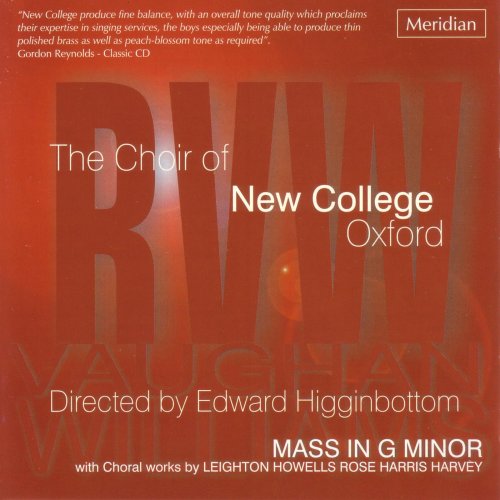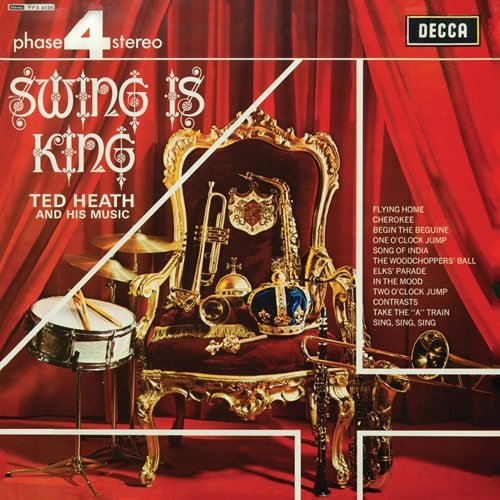The Choir of New College, Oxford, Edward Higginbottom - Vaughan Williams: Mass in G Minor (2007)

Artist: The Choir of New College, Oxford, Edward Higginbottom
Title: Vaughan Williams: Mass in G Minor
Year Of Release: 2007
Label: Meridian Records
Genre: Classical
Quality: FLAC (tracks)
Total Time: 00:56:38
Total Size: 238 MB
WebSite: Album Preview
Tracklist:Title: Vaughan Williams: Mass in G Minor
Year Of Release: 2007
Label: Meridian Records
Genre: Classical
Quality: FLAC (tracks)
Total Time: 00:56:38
Total Size: 238 MB
WebSite: Album Preview
01. The Choir of New College - Mass in G Minor: I. Kyrie (4:05)
02. The Choir of New College - Mass in G Minor: II. Gloria (4:17)
03. The Choir of New College - Mass in G Minor: III. Credo (6:49)
04. The Choir of New College - Mass in G Minor: IV. Sanctus (3:01)
05. The Choir of New College - Mass in G Minor: V. Benedictus (2:30)
06. The Choir of New College - Mass in G Minor: VI. Agnus Dei (4:29)
07. The Choir of New College - God's Grandeur (5:15)
08. The Choir of New College - Take Him, Earth, for Cherishing (9:01)
09. The Choir of New College - Feast Song for Saint Cecilia (6:04)
10. The Choir of New College - Faire is the Heaven (5:38)
11. The Choir of New College - I Love the Lord (5:33)
This magnificent piece was first performed by the Birmingham City Choir in 1922, and commentators agreed that its distinctive sound pattern stems from the seemingly effortless and triumphant union of old
and new. Richard Terry, an active figure in the return to the English Renaissance music scene (if I may say so), who conducted the first liturgical performance
at Westminster Cathedral in 1923, pointed out this feature from the very beginning: "In your individual and modern style, you really caught
the spirit and atmosphere of the old liturgy." This ancient spirit is heard in her modality (neither major nor minor) and subtle use of false relationships (notes in dissonant
conflict) and imitation lines. His modernity lies in the score for double choir and solo quartet (reminiscent of Vaughan Williams' earlier hit
for strings "Fantasy on a Theme by Thomas Tallis"), as well as in the rich texture, shifting harmonies; and, perhaps, also in his development of the originally English
sound world.
The first of the five movements, Kyrie, begins and ends with a sinuous alto line that seems to recall that
Auden described it wonderfully as "the swaying sound of the sea." The rest of the piece smoothly rises and recedes, reaching the crest, like a majestic wave, and
subsides again.
Gloria and Credo bring into effect the antiphonal (call-and-response) effects characteristic of the work. After the quiet, shimmering introduction of "Et in terra pax",
lulling into a false sense of peace, thrilling choral waves roll in one after another, interrupted by piercing inserts of solo parts. Dynamics
It varies from full volume (ff) to barely audible whisper (four-letter p!).
The next two movements bring us back to the mostly calm seas, interrupted by energetic hosannas: "Sanctus" begins as an unearthly sunrise
at sea, then the fugue (imitative) "Pleni sunt caeli" dances like playful waves. "Benedictus" is inexpressibly tender, it is a gentle exchange of feelings between choirs
and soloists.
Agnus Dei seems to enclose the work in a microcosm, with her skilful use of antiphony between choirs and soloists, where episodes of excitement are balanced by moments of otherworldly peace. The climax
– a part, and possibly the entire work, begins on the last page, where the quartet and two choirs merge into powerful chord columns of ecstatic
sound. The solo soprano soars above the peak in a radiant la, and the effect is like the sunrise over the sea, which was stormy at times, but now subsides in
perfect, shimmering calm.
and new. Richard Terry, an active figure in the return to the English Renaissance music scene (if I may say so), who conducted the first liturgical performance
at Westminster Cathedral in 1923, pointed out this feature from the very beginning: "In your individual and modern style, you really caught
the spirit and atmosphere of the old liturgy." This ancient spirit is heard in her modality (neither major nor minor) and subtle use of false relationships (notes in dissonant
conflict) and imitation lines. His modernity lies in the score for double choir and solo quartet (reminiscent of Vaughan Williams' earlier hit
for strings "Fantasy on a Theme by Thomas Tallis"), as well as in the rich texture, shifting harmonies; and, perhaps, also in his development of the originally English
sound world.
The first of the five movements, Kyrie, begins and ends with a sinuous alto line that seems to recall that
Auden described it wonderfully as "the swaying sound of the sea." The rest of the piece smoothly rises and recedes, reaching the crest, like a majestic wave, and
subsides again.
Gloria and Credo bring into effect the antiphonal (call-and-response) effects characteristic of the work. After the quiet, shimmering introduction of "Et in terra pax",
lulling into a false sense of peace, thrilling choral waves roll in one after another, interrupted by piercing inserts of solo parts. Dynamics
It varies from full volume (ff) to barely audible whisper (four-letter p!).
The next two movements bring us back to the mostly calm seas, interrupted by energetic hosannas: "Sanctus" begins as an unearthly sunrise
at sea, then the fugue (imitative) "Pleni sunt caeli" dances like playful waves. "Benedictus" is inexpressibly tender, it is a gentle exchange of feelings between choirs
and soloists.
Agnus Dei seems to enclose the work in a microcosm, with her skilful use of antiphony between choirs and soloists, where episodes of excitement are balanced by moments of otherworldly peace. The climax
– a part, and possibly the entire work, begins on the last page, where the quartet and two choirs merge into powerful chord columns of ecstatic
sound. The solo soprano soars above the peak in a radiant la, and the effect is like the sunrise over the sea, which was stormy at times, but now subsides in
perfect, shimmering calm.
Download Link Isra.Cloud
The Choir of New College, Oxford - Vaughan Williams: Mass in G Minor (2007)
My blog
The Choir of New College, Oxford - Vaughan Williams: Mass in G Minor (2007)
My blog
![Robin Fincker, Janick Martin - Vison Visu (2025) [Hi-Res] Robin Fincker, Janick Martin - Vison Visu (2025) [Hi-Res]](https://img.israbox.com/img/2025-10/18/1lr93964jqeaz5q5e3frn9123.jpg)




![Sokratis Sinopoulos & Yann Keerim - Topos (2025) [Hi-Res] Sokratis Sinopoulos & Yann Keerim - Topos (2025) [Hi-Res]](https://www.dibpic.com/uploads/posts/2025-10/1760453151_c085wvwlv9fob_600.jpg)


